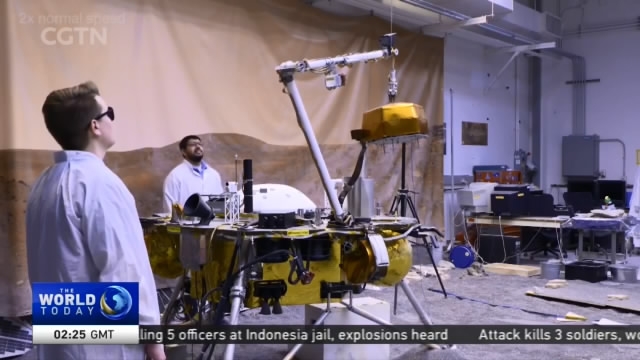
10:37, 10-May-2018
NASA Mars Mission: InSight Lander will be first to study Red Planet's interior
02:47

A robotic geologist of sorts is now winging its way to Mars. The latest mission to the Red Planet by the U.S. space agency NASA began this past Saturday with the launch of the InSight Lander. For the first time ever, a spacecraft will study the interior of Mars. CGTN's Hendrik Sybrandy reports from the state of Colorado, where the lander was built.
Through the pre-dawn fog, an Atlas 5 rocket powered the very first interplanetary launch from California, as opposed to Florida, where all such launches have taken place before.
"And NASA's Insight, the first outer space robotic explorer to study the interior of Mars."
The Mars InSight spacecraft will spend the next six and a half months hurtling towards the Red Planet where, if all goes well, it will perform some ground-breaking science, literally.
PIETER KALLEMEYN TEAM LEAD, INSIGHT SPACECRAFT "When a mission gets off the ground at the very first launch opportunity, that's something pretty special."
Pieter Kallemeyn is InSight's Team Lead. He'll help oversee a two-year geological examination of what lies beneath Mars' surface.
BRUCE BANERDT PRINCIPAL INVESTIGATOR, INSIGHT SPACECRAFT "We're going to map out the thickness of the crust, the size of the core, the composition of the mantle and core for the planet, sort of get the first map of the deep inside of Mars."
A seismometer placed by a robotic arm on Mars' surface will measure earthquakes and the impact of meteorites. A probe that uses a self-hammering mechanical mole to burrow five meters below the surface will measure how heat flows in Martian soil. And an onboard radio will track the wobble in Mars' spin. That could reveal how much liquid rests deep inside the planet.
DAVE BRAIN LABORATORY FOR ATMOSPHERIC AND SPACE PHYSICS "The interior of a planet is incredibly difficult to investigate because we can't go there. It feels close but it's really far away."
HENDRIK SYBRANDY DENVER "Mars expert Dave Brain compares Earth and Mars, which have similar geological features although Mars is half the size, to two baked potatoes."
DAVE BRAIN LABORATORY FOR ATMOSPHERIC AND SPACE PHYSICS "And small potatoes cool off quicker than large baked potatoes."
By studying the interior of a planet that may be quite different from ours, he believes.
"We can make this nice comparison between a big planet and a small planet that teaches us more about how Earth should evolve going forward."
The InSight mission will be run by the U.S. aerospace company Lockheed Martin from its Colorado facility. It's where the spacecraft was built. It's scheduled to arrive at Mars on November 26th. Its descent to the ground will be tricky.
PIETER KALLEMEYN TEAM LEAD, INSIGHT SPACECRAFT "So that we go from 12,000 miles per hour at the start down to zero and that all happens in the span of seven minutes."
Not long after touchdown, this new, deeper exploration of the planet is set to begin. Hendrik Sybrandy, CGTN, Denver.

SITEMAP
Copyright © 2018 CGTN. Beijing ICP prepared NO.16065310-3
Copyright © 2018 CGTN. Beijing ICP prepared NO.16065310-3